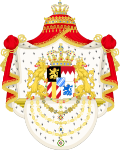This article needs additional citations for verification .(February 2024) |
Jacobite consorts are those who were married to a Jacobite pretender to the thrones of England, Scotland and Ireland since the abdication of James II in 1688. By Jacobites they are thus regarded, if female, as rightful Queens Consort of England, Scotland and Ireland. Since the death of Marie-Jenke, Duchess of Bavaria in 1983, there has been no Jacobite consort; the current pretender, Franz, Duke of Bavaria, is not married.
After 1807, the succession passed from the House of Stuart, and none of the Jacobite heirs since has actually claimed the thrones of England and Scotland or incorporated the arms of England and Scotland in their coats-of-arms.
| Portrait | Name | Arms | Father | Birth | Marriage | Became consort | Ceased to be consort | Death | Spouse |
|---|---|---|---|---|---|---|---|---|---|
 | Mary of Modena | Alfonso IV d'Este, Duke of Modena (Este) | 5 October 1658 | 30 September 1673 (by proxy) | 6 February 1685 husband's accession 11 December 1688 (England) / 11 May 1689 (Scotland) husband became pretender | 16 September 1701 husband's death | 7 May 1718 | James II & VII | |
 | Maria Clementina Sobieska | James Louis Sobieski (Sobieski) | 18 July 1702 | 3 September 1719 | 18 January 1735 | James III & VIII | |||
 | Princess Louise of Stolberg-Gedern | Prince Gustav Adolf of Stolberg-Gedern | 20 September 1752 | 28 March 1772 (by proxy) | 31 January 1788 husband's death | 29 January 1824 | Charles III | ||
 | Maria Theresa of Austria-Este Queen of Sardinia | Ferdinand, Duke of Breisgau (Austria-Este) | 1 November 1773 | 25 April 1789 | 6 October 1819 husband's accession | 10 January 1824 husband's death | 29 March 1832 | Victor | |
 | Francis IV, Duke of Modena | 6 October 1779 | 20 June 1812 | 10 January 1824 wife's accession | 15 September 1840 wife's death | 21 January 1846 | Mary III & II | ||
 | Princess Adelgunde of Bavaria Duchess of Modena | Ludwig I of Bavaria (Wittelsbach) | 19 March 1823 | 20 March 1842 | 20 November 1875 husband's death | 28 January 1914 | Francis I | ||
 | Ludwig III of Bavaria |  | Luitpold, Prince Regent of Bavaria (Wittelsbach) | 7 January 1845 | 20 February 1868 | 20 November 1875 wife's accession | 3 February 1919 wife's death | 18 October 1921 | Mary IV & III |
 | Princess Antonia of Luxembourg Crown Princess of Bavaria | William IV, Grand Duke of Luxembourg (Nassau-Weilburg) | 7 October 1899 | 7 April 1921 | 31 July 1954 | Robert I & IV | |||
| - | Countess Maria Draskovich of Trakostjan Duchess of Bavaria | Count Dionys Maria Draskovich of Trakostjan (Drašković) | 8 March 1904 | 3 September 1930 | 2 August 1955 husband's accession | 10 June 1969 | Albert | ||
| - | Countess Marie-Jenke Keglevich of Buzin Duchess of Bavaria | Count Stephan Keglevich of Buzin (Keglević of Buzin) | 23 April 1921 | 21 April 1971 | 5 October 1983 | ||||
| VACANT | |||||||||
Henry Benedict Stuart (pretender 1788-1807, as Henry IX & I) and Franz, Duke of Bavaria (pretender 1996–present, as Francis II) never married (Henry was a Catholic priest, bishop, and cardinal; [1] Franz is gay and has a male partner [2] ). Marie Clotilde of France, wife of Charles Emmanuel IV of Sardinia (pretender 1807-1819, as Charles IV), died before her husband became pretender, as did Duchess Marie Gabrielle in Bavaria, first wife of Rupprecht, Crown Prince of Bavaria (Robert I & IV).